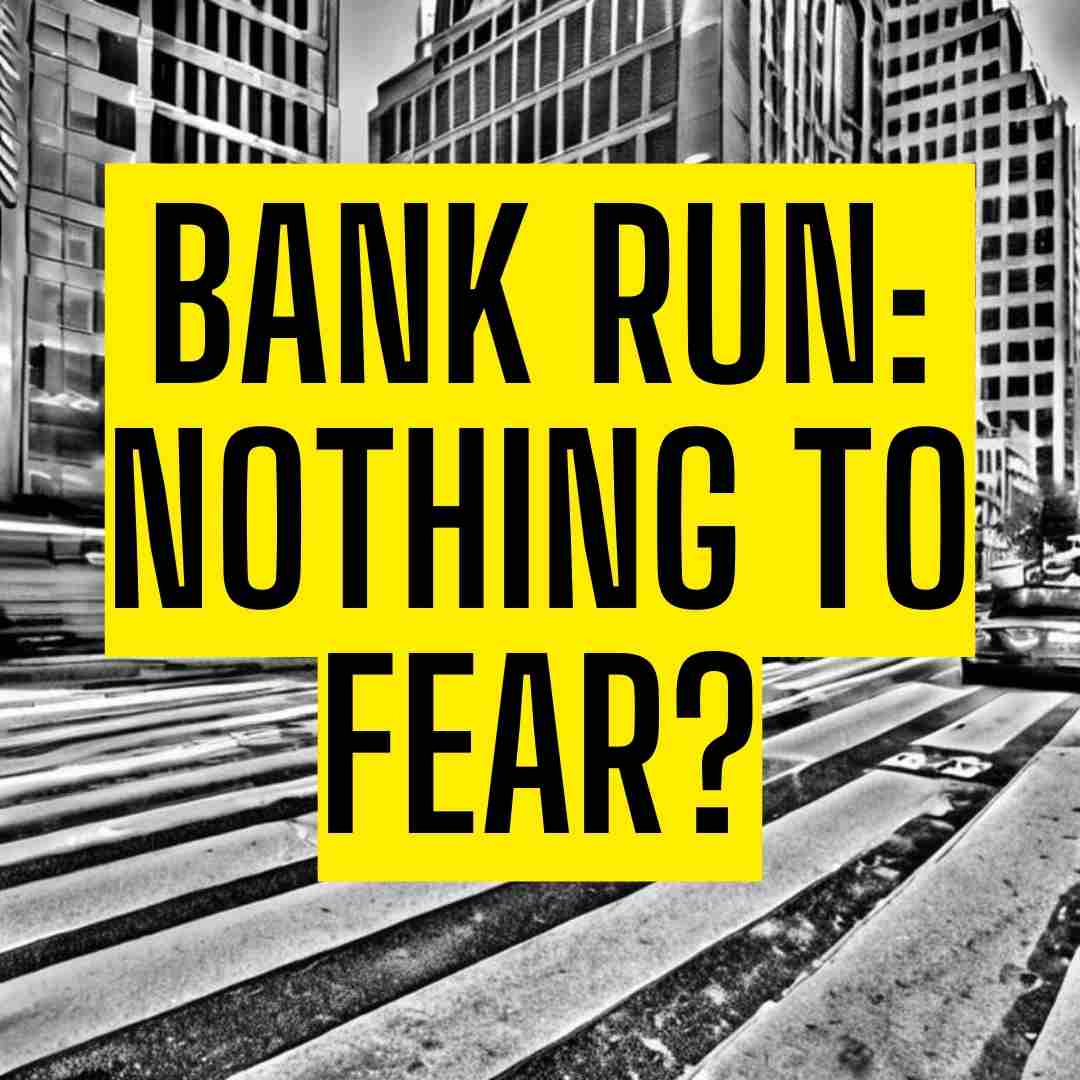It’s odd that when it comes to our riches, we run the globe through faith in man-made shell games. Silvergate Bank, a crypto-focused bank with over $6 billion in deposits went bankrupt last week, and thanks to the speed at which news like this travels, it was just another Netflix series to binge on, covering the tried and true theme that worked for 2022: Wherever crypto goes, things break! There’s always more to learn from unpacking the story though, and this is my perspective at this point in time.
Over the last week, we’ve witnessed some of the largest bank failures since the Great Depression. I wonder if there’s something we should take notice of.
Even before my formal education, Jimmy Stewart in ‘It’s a Wonderful Life’ introduced me to the science behind a bank run. Deposit your money at a bank, knowing it’s always going to be there when you need it. One day, perhaps you and a few others get a little nervous about the security of the bank, even for entirely irrational reasons – what next? You head down to the bank to find a line out the door and limits on cash withdrawals. Even mentioning ‘bank run’ could be enough to trigger a real bank run if uttered at the wrong time (so I’ll be as careful as I can here!). Banks don’t keep all your cash at a local branch – they only keep as much as they need, to satisfy average demand.
Everyone likes to say that money isn’t everything, but it’s linked to almost everything, so we need to pay attention when banks fail. Ignoring the rails on which our wealth moves on is ill-advised.
Back to Silvergate. According to one article, Silvergate is closing its doors owing to “turbulence in digital currency markets,” citing a regulatory filing released earlier this week. The next article I read discusses Silicon Valley Bank (SVB) and the next one talks about Signature – all failures (and all being bailed out as I type). Many will blame this on crypto, but this isn’t smart. What I’ve learned about crypto thus far, is that price volatility is something that shouldn’t catch anyone playing in this space off guard – those surprised and blaming crypto volatility for a loss have two reasons to fall back on: Either they’re not prepared for risk, or they’re not bothered by it. Rather than think of this as a ‘crypto-thing’, I feel it’s important to think of this instead as a ‘system’ thing.
Thankfully (unless you’re into crypto and start-ups), it appears mainstream banks at this moment in time, are relatively unaffected with this set of bank failures in the US. What happens if interest rates go higher though? if lower rates progressively led to higher risk asset bubbles in the recent past, then the opposite outcome should unfold when interest rates start moving the other way around. This makes sense, especially when you consider pretty much everything goes to zero in an infinite interest rate world. Crypto volatility is only the spark; we have to investigate the underlying source of pain a bit further here though. The most common denominator in the current set of failures appears to be an increasing distaste to the ‘higher, faster, and for longer’ medicine central banks are serving up via higher interest rates.
Higher interest rates affect everything. From Silicon Valley cypher punks to my everyday neighbour. We’re all groaning under the influence of a heavy-handed Jerome Powell, either directly or indirectly, pretty much over the entire globe. Crypto, start-ups, tech companies, property and even bonds – consider those in monetary authority and their ability to create or destroy your wealth. How did we get here so fast?
The stock price of Silvergate Bank, which went public in late 2019 for $13, increased by 1,580% the following year as the company established itself as a prominent fiat-to-crypto service provider. The bank expanded alongside most high-risk assets, exactly at the time when interest rates were in decline.
Failing banks serving the higher-risk investment community may be an ‘acceptable’ loss in the war against inflation for some. For others, it’s a picture of what could happen in the well-behaved suburbs of the investment community too. The fact people like me are taking notice, is cause for concern. Why? Because you and I already don’t feel that safe after the last few years we’ve had and we’re more likely to act irrational. It’s even worse if you can still hear Jimmy Stewart in your head screaming, ‘You’re thinking of this place all wrong, as if I had the money back in a safe. The money’s not here. Well, your money’s in Joe’s house – that’s right next to yours – and in the Kennedy house and Mrs. Maitland’s house and 100 others.’ What happens when the people start asking for their money right at the point in time in which the banks are weak?
In the Silvergate example there were withdrawals totalling more than $8 billion in January alone. The bank had to sell ‘held-to-maturity’ assets to cover the withdrawals, incurring a $718 million loss in the process. Payments became due when the bank’s longer-term assets became less valuable.
Several high-profile bank-like crypto firms failed last year, including Celsius, Voyager, and FTX. Even after this, many would suggest the oil of ‘the new’ (crypto) doesn’t mix well with the water of today, but it’s not crypto that’s at fault, it’s the environment in which it operates in. When contrasted with the traditional financial system, this statement can’t be easily ignored. In total, 512 banks have failed since 2009.
In reading up a bit more around this, I kept coming across the term ‘maturity mismatch’. To make a profit in the banking industry, it appears the strategy is to ‘borrow short and lend long’; if the interest rate on savings accounts is lower than the interest rate on mortgages, banks are winning. In this simple example, you can see how banks could have times when their liabilities were due (customers want cash), but their assets were ‘pre-occupied’ (ie locked into longer term mortgages earning a higher return). * Keep in mind that the bank’s ‘assets’ are loans, and their ‘liabilities’ are customer deposits. A maturity mismatch may cause a ‘liquidity crisis,’ in which the bank is unable to repay depositors if they all come knocking at the same time (hello ‘bank run!’). Unless a bank felt rising interest rates, like inflation, are simply temporary, managing these risks through sophisticated hedging techniques are the prudent approach. This way, regardless of the direction of interest rates, banks can still be profitable no matter what the environment is. Hence, in an odd sort of way, it appears as though sometimes, a centralised monetary authority, or central bank, can increase the risk of bank solvency events whenever it increases ‘official’ interest rates. This is because higher rates, lower the value of the assets of a bank. Sounds like a bit of a road block in the battle against inflation?
This is when things become interesting though. If confidence in the financial system is important to regulators, you wouldn’t want to do anything to make the banks insolvent. I also understand central banks believe that by creating inflation in theory, you can cure inflation (Higher mortgage payments). Surely a central bank wouldn’t put the banking system at risk. I imagine the academics at the various central banks around the world have a super robust process of debating the merits of Keynesian inspired policy and its effectiveness in the new world (and this is why we have absolutely nothing to fear).
Consider this theory though just for fun: Interest rates and financial stability are negatively correlated (if you dial up one of these things, the other thing goes down.)
In the same way that inflation is used to battle inflation (by causing a financial shock to arrest rising costs), it appears that financial stability is now being sacrificed for the sake of, you guessed it, financial stability. Lower rates, borrowers rejoice, and asset prices skyrocket. Higher rates, then happy savers win. So far, so good, but what happens if interest rates rise further? Starting with the poor (and those least able to increase their income), and then moving on to the middle class, we all start depleting our savings as we individually adapt to higher costs. We’ll need to access our short-term cash at a time when banks may be obliged to realise losses on assets declining in value due to the same rising rates.
Setting interest rates too high, has consequences for our asset prices. That much you hear about. It also increases inequality, generates distress in our homes, induces suicide, and causes us to lose confidence as a country. Going higher and staying there for longer moves beyond treating inflation, to destroying the fabric of society really quick.
Surely, our own central bank anticipated these outcomes before following the script handed to them. Just in case it’s not clear – this all happened because central banks went bananas when they should have been feeding us grapes.
In the past, regulators implemented precautionary measures such as stress testing and establishing minimum capital requirements. In the United States, there’s FDIC insurance that covers $250k in the case of a bank failure – with all 3 banks mentioned in this article by the way, FDIC insurance is going to be relied on. In New Zealand, we have something similar to this, providing protection of up $100,000, but it’s likely only to become legislation in 2024.
Preparing for a bank run here in NZ is not something I’m suggesting you do. New Zealand banks fared well in 2008 and from what I hear, they sound super profitable. As an investor, continual market awareness is a small price to pay for insurance against uncertain times though. If you have faith that in the long term, a traditional approach to investing is a prudent strategy (and that’s a pretty safe bet btw!) this really should cause you no concern whatsoever. Having said that, many local commentators often remain silent on a risk we all quietly worry about. There’s a blind spot everyday investors have as a result: No one talks about the risk of systemic failure of the banking system. It’s not a profitable concern for one’s own career in this field, but I believe we should be framing a diversification discussion using old and new, alternative forms of decentralised money.
While we’re mostly still listening to the band, the spirit of those who built the Titanic are reassuring us – “Just repeat after me…’we’re too big to fail’.
References:
https://www.bankrate.com/banking/list-of-failed-banks/
https://www.investopedia.com/terms/m/maturitymismatch.asp
https://www.barrons.com/articles/svb-silicon-valley-bank-rates-securities-693c931c





